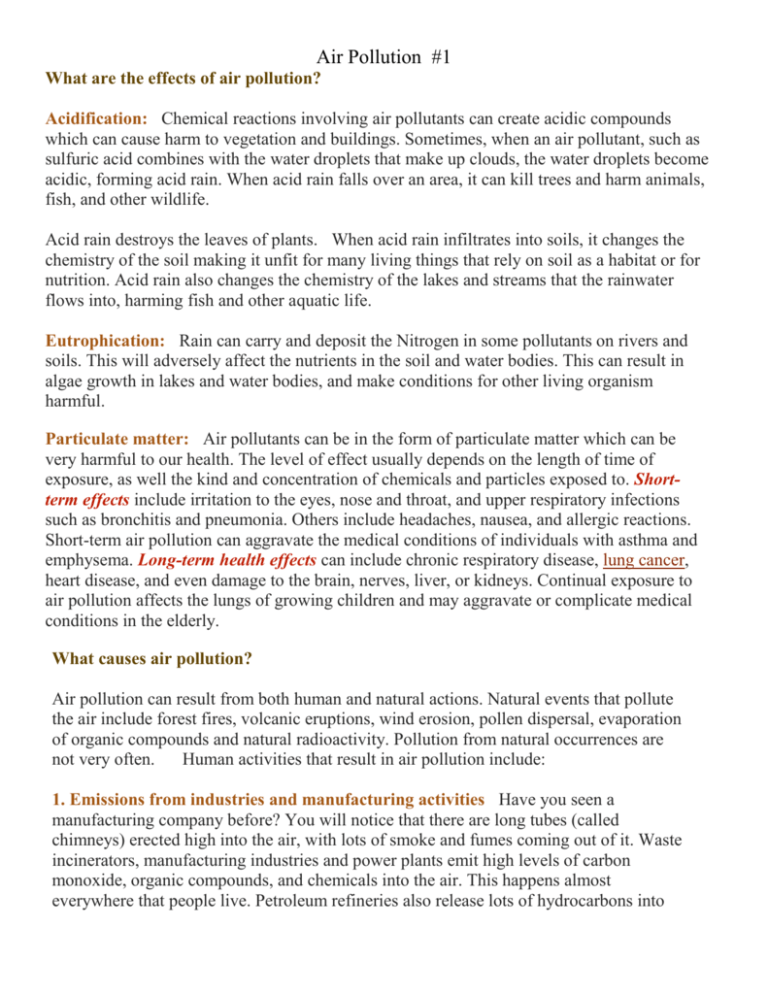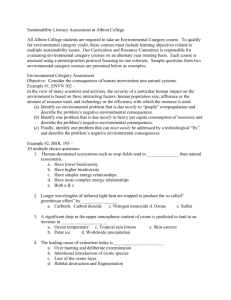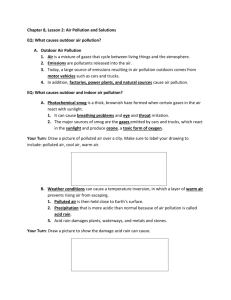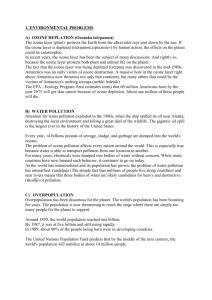File
advertisement

Air Pollution #1 What are the effects of air pollution? Acidification: Chemical reactions involving air pollutants can create acidic compounds which can cause harm to vegetation and buildings. Sometimes, when an air pollutant, such as sulfuric acid combines with the water droplets that make up clouds, the water droplets become acidic, forming acid rain. When acid rain falls over an area, it can kill trees and harm animals, fish, and other wildlife. Acid rain destroys the leaves of plants. When acid rain infiltrates into soils, it changes the chemistry of the soil making it unfit for many living things that rely on soil as a habitat or for nutrition. Acid rain also changes the chemistry of the lakes and streams that the rainwater flows into, harming fish and other aquatic life. Eutrophication: Rain can carry and deposit the Nitrogen in some pollutants on rivers and soils. This will adversely affect the nutrients in the soil and water bodies. This can result in algae growth in lakes and water bodies, and make conditions for other living organism harmful. Particulate matter: Air pollutants can be in the form of particulate matter which can be very harmful to our health. The level of effect usually depends on the length of time of exposure, as well the kind and concentration of chemicals and particles exposed to. Shortterm effects include irritation to the eyes, nose and throat, and upper respiratory infections such as bronchitis and pneumonia. Others include headaches, nausea, and allergic reactions. Short-term air pollution can aggravate the medical conditions of individuals with asthma and emphysema. Long-term health effects can include chronic respiratory disease, lung cancer, heart disease, and even damage to the brain, nerves, liver, or kidneys. Continual exposure to air pollution affects the lungs of growing children and may aggravate or complicate medical conditions in the elderly. What causes air pollution? Air pollution can result from both human and natural actions. Natural events that pollute the air include forest fires, volcanic eruptions, wind erosion, pollen dispersal, evaporation of organic compounds and natural radioactivity. Pollution from natural occurrences are not very often. Human activities that result in air pollution include: 1. Emissions from industries and manufacturing activities Have you seen a manufacturing company before? You will notice that there are long tubes (called chimneys) erected high into the air, with lots of smoke and fumes coming out of it. Waste incinerators, manufacturing industries and power plants emit high levels of carbon monoxide, organic compounds, and chemicals into the air. This happens almost everywhere that people live. Petroleum refineries also release lots of hydrocarbons into Air Pollution #1 the air. 2. Burning Fossil Fuels After the industrial age, transportation has become a key part of our lives. Cars and heavy duty trucks, trains, shipping vessels and airplanes all burn lots of fossil fuels to work. Emissions from automobile engines contain both primary and secondary pollutants. This is a major cause of pollution, and one that is very difficult to manage. This is because humans rely heavily on vehicles and engines for transporting people, good and services. Fumes from car exhauts contain dangerous gases such as carbon monoxide, oxides of nitrogen, hydrocarbons and particulates. On their own, they cause great harm to people who breath them. Additionally, they react with environmental gases to create further toxic gases. 3. Household and Farming Chemicals Crop dusting, fumigating homes, household cleaning products or painting supplies, over the counter insect/pest killers, fertilizer dust emit harmful chemicals into the air and cause pollution. In many case, when we use these chemicals at home or offices with no or little ventilation, we may fall ill if we breathe them. What are the common air pollutants around? Carbon Monoxide (CO) Fuel combustion from vehicles and engines. Reduces the amount of oxygen reaching the body’s organs and tissues; aggravates heart disease, resulting in chest pain and other symptoms. Ground-level Ozone (O3) Secondary pollutant formed by chemical reaction of volatile organic compounds (VOCs) and NOx in the presence of sunlight. Decreases lung function and causes respiratory symptoms, such as coughing and shortness of breath, and also makes asthma and other lung diseases get worse. Nitrogen Dioxide (NO2) Fuel combustion (electric utilities, big industrial boilers, vehicles) and wood burning. Worsens lung diseases leading to respiratory symptoms, increased susceptibility to respiratory infection. Particulate Matter (PM) This is formed through chemical reactions, fuel combustion (e.g., burning coal, wood, diesel), industrial processes, farming (plowing, field burning), and unpaved roads or during road constructions. Short-term exposures can worsen heart or lung diseases and cause respiratory problems. Long-term exposures can cause heart or lung disease and sometimes premature deaths. Sulfur Dioxide (SO2) SO2 come from fuel combustion (especially high-sulfur coal); electric utilities and industrial processes as well as and natural occurrences like volcanoes. Aggravates asthma and makes breathing difficult. It also contributes to particle formation with associated health effects. Air Pollution #1 What is Ozone? Ozone is a natural gas composed of three atoms of oxygen. It chemical symbol is O3. It is blue in color and has a strong odor. Normal oxygen (O2), which we breathe, has two oxygen atoms and is colorless and odorless. Environmental scientists have classified O3 into two: Good Ozone and Bad Ozone. Good Ozone Good ozone (also called Stratospheric Ozone) occurs naturally in the upper Stratosphere. The stratosphere is the layer of space 6 to 30 miles above the earth's surface. Where does good Ozone come from? The air is full of gases reacting with each other, even though our eyes do not see. When UV light strikes (Oxygen) O2 molecules, they are split into two individual O atoms — O and O. When one of the O atoms combine with O2 molecule, ozone (O3) is created. Even though Ozone is only a small part of the gases in this layer, it plays a vital role because it shields us from the sun's harmful UV rays. It is called Good Ozone, for obvious reasons—because it protects humans, life and animals on earth. Bad Ozone Bad Ozone is also known as Tropospheric Ozone, or ground level ozone. This gas is found in the troposphere, the layer that forms the immediate atmosphere. Bad Ozone does not exist naturally. Human actions cause chemical reactions between oxides of nitrogen (NOx) and volatile organic compounds (VOC). Where does bad ozone come from? Each time there is a reaction of chemicals such as those found in cars, power plants and factory emissions, in the presence of sunlight (UV light), Bad Ozone is created. Bad ozone contaminates (dirties) the air and contributes to what we typically experience as "smog" or haze. Note that this kind of smog is different from the deadly London winter type that killed 4000 people. Smog from bad ozone is usually in the summer, caused by the action of sunlight on a mixture of hydrocarbons and oxides of nitrogen. It is known as Photochemical or Summer Smog.







